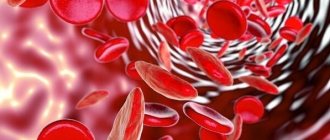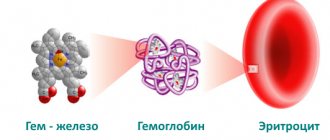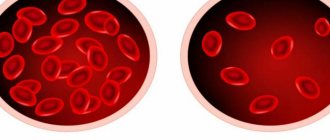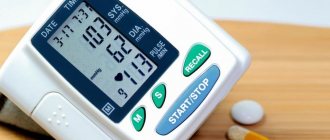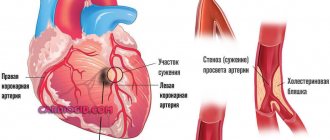Hemoglobin is a special blood protein found in red blood cells. Performs a vital function. Thanks to it, cells and tissues are saturated with oxygen, and gases and substances are exchanged in the body. Therefore, the importance of hemoglobin cannot be overestimated. If its level drops, health problems occur. This could be due to various reasons. So it is necessary to maintain a normal protein level and know ways to restore it.
Symptoms of high hemoglobin
Initially, it is necessary to sort out what complaints does a woman have with increased hemoglobin?
The condition of increased hemoglobin is called hyperhemoglobinemia and very often occurs without the manifestation of clinical signs. In most cases, high hemoglobin in women and men is detected only during a routine general clinical examination. In some cases, hyperhemoglobinemia is accompanied by the following symptoms:
- increased blood pressure and swollen veins;
- a feeling of aching in bones and joints;
- decreased performance;
- weakness and drowsiness;
- shortness of breath even when walking calmly;
- slight blueness of the fingertips;
- pallor or flushing of the face;
- losing weight for no apparent reason;
- decreased concentration and absent-mindedness;
- long and painful menstruation;
- neurotic disorders, psychoses, insomnia, depression.
Often the causes of high hemoglobin levels in women and men are a concomitant disease. In this case, the symptoms of hyperhemoglobinemia are similar to the clinical manifestations of the underlying pathology. This fact explains the difficulties for differential diagnosis of hyperhemoglobinemia itself and identifying its causes.
Hemoglobin during pregnancy
During pregnancy, elevated hemoglobin is extremely rare. As a rule, a single increase in Hb concentration is not significant, since the levels of all indicators change during the day against the background of physical or emotional activity. However, consistently high levels may indicate a lack of B vitamins or the development of a pathological process. In this case, a comprehensive examination of the patient is prescribed to eliminate the hyperhemoglobinemia condition as quickly as possible. This is necessary to reduce the risk of developing thrombosis and fetal hypoxia.
Pregnant women are more often characterized by a state of hypohemoglobinemia - a deficiency of hemoglobin levels against the background of blood thinning, as a result of an increase in its volume.
For early diagnosis of deviations from the norm when planning to conceive a child, a course of preventive measures is recommended to prevent a decrease in Hb concentration. This will significantly reduce the risk of developing any type of anemia.
Read further: What is hemoglobin in the blood, its types, how is it tested.
How does alcohol affect? The influence of periodic women's days
Frequently asked questions and doctor's answer
General practitioner Victoria Druzhikina answered questions
1. What is Hemoglobin indicated in a blood test?
- “In a general blood test, hemoglobin is abbreviated as Hb, measured in grams per liter.” 2. Why is low Hemoglobin dangerous?
– “Low hemoglobin levels are dangerous due to anemia and its consequences:
- oxygen starvation of organs and tissues, primarily nervous;
- muscle weakness;
- fainting due to decreased blood pressure;
- decreased immunity;
- wear and tear of the heart muscle due to the development of compensatory tachycardia in conditions of lack of oxygen;
- heart attacks;
- retardation in mental and physical development.
In severe cases, untreated anemia can lead to hypoxic coma and death due to brain or heart failure.”
3. Blood transfusion for low hemoglobin
– “To treat severe forms of anemia, blood or red blood cell transfusions are used. The procedure is indicated in 2 cases:
1. With a hemoglobin level of 70 g/l and below.
2. In case of poor tolerance to anemia and the threat of hypoxic coma at any level of hemoglobin. This can occur in people whose lives involve high oxygen consumption - pregnant women, athletes, scuba divers playing wind instruments.
The standard regimen is 2 doses (1 dose – 200 ml) twice a week. Before and after the procedure, general urine and blood tests and temperature must be monitored.
Before the manipulation, the patient’s blood type and Rh factor are determined, and donor blood is selected based on these indicators. Next, the compatibility of the blood samples is checked. If the reaction proceeds normally, a transfusion is performed. If flakes or clots form, this blood is not transfused, but other samples are tested for compatibility.” 4. Hemoglobin norm in children under one year old
– “The hemoglobin norm in children under one year of age is determined by physiological factors. By the end of the 1st month, the numbers are higher than in adults and amount to 160–200 g/l.”
5. How to increase Hemoglobin in a child?
“If anemia is detected, it is important to increase hemoglobin levels as soon as possible, especially in children. The main role in this belongs to drugs. Unfortunately, nutrition will not significantly increase the numbers. With the help of food, you can only slightly improve your performance and maintain it at this level.
Foods to increase hemoglobin in children:
- beef;
- buckwheat;
- cocoa;
- liver;
- apples;
- pomegranate;
- walnuts.
Drugs for the treatment of anemia in children:
- Maltofer;
- Ferrum Lek;
- Totema;
- Ferlatum and others"
6. How to increase hemoglobin during pregnancy?
“During pregnancy, it can be difficult for a woman to follow a diet with foods rich in iron. However, their list is quite wide, you can choose what you like:
- beef;
- wheat bran;
- hazelnuts;
- cabbage, including broccoli;
- chocolate;
- rabbit;
- liver;
- cocoa;
- apples;
- pears;
- parmesan, etc.
How to increase hemoglobin during pregnancy - the most used drugs:
- Maltofer;
- Sorbifer Durules;
- Ferrum Lek;
- Gyno-tardiferon;
- Totema;
- Ferlatum and others."
7. Iron supplements to increase hemoglobin in adults
– “To treat anemia in adults, the same drugs are used as for pregnant women. Can also be used:
- Venofer;
- Ferlatum protein;
- Cosmopher;
- vitamin complexes with iron (Ferro-Folgamma, Fenyuls, etc.).”
8. Normal Hemoglobin in Newborns? – “The hemoglobin norm varies slightly from month to month, the generally accepted average values are 120–160 g/l.
Immediately after birth, the mother’s blood circulates in the baby, so values from 180 to 240 g/l are considered normal for the 1st week of life.”
For information on hemoglobin levels, see also the video:
This article has been verified by a current qualified physician, Victoria Druzhikina, and can be considered a reliable source of information for site users.
Bibliography
1. The norms of indicators are indicated in Appendix No. 3 of Order of the Ministry of Health of the Russian Federation dated 09/14/2001 364 (as amended on 06/06/2008)
Rate how useful article
4.7 was. 29 people voted, average rating 4.7
Did you like the article? Save it to your wall so you don’t lose it!
High hemoglobin in women - what does it mean and what should be done
Doctors are often asked the question - what does it mean if a woman has increased hemoglobin? As a rule, this condition is caused by a lack of oxygen in the blood. In order to compensate, the body begins to actively produce red blood cells containing Hb molecules.
To prevent the risk of developing complications in the form of thrombosis, mandatory correction of high hemoglobin levels is necessary. If such a condition is caused by external factors, then when they are eliminated, the Hb value returns to normal. In a situation where hyperhemoglobinemia is a concomitant symptom of the disease, initial elimination of the underlying pathology is necessary.
Reasons for the increase
Factors that cause an increase in hemoglobin levels can be exogenous (external) or endogenous (internal).
Exogenous causes. An increase in hemoglobin levels may be associated with a person’s type of activity. Thus, pilots, residents of high mountains and climbers who spend significant time at high altitudes experience hypoxia. Therefore, immediately after the flight, the Hb concentration will be higher than normal. Taking certain medications, such as steroids, also affects this laboratory indicator.
During long-term training with heavy loads, a huge amount of oxygen is consumed, which, with the correct technique, is compensated by frequent and deep breathing. If technology is violated, an increase in hemoglobin levels is observed in the body.
Endogenous causes. Diabetes mellitus and mental disorders accompanied by stress reactions can also cause Hb deviations from the norm. And in the case of a benign tumor process of the circulatory system (Vaquez disease), an increase in the concentration of red blood cells becomes malignant.
When taking medications that lead to excessive absorption of iron ions in the blood against the background of malfunctions of the enzymatic system, the Hb level increases.
Reasons for the downgrade
Low Hb concentrations are observed against the background of the following pathological conditions:
- anemia of various types;
- failures of hemoglobin synthesis processes;
- liver diseases;
- ulcers of the stomach and duodenum;
- chronic kidney disease, which results in a decrease in the concentration of the hormone erythropoiesin, the main role of which is the activation of the formation of red blood cells in the bone marrow;
- hypofunction of the thyroid gland;
- blood hemolysis - destruction of red blood cells;
- oncological diseases accompanied by metastases to the bone marrow;
- chronic pathologies of connective tissue;
- infectious process.
Read further: Tables of norms with explanations of indicators in a biochemical blood test
Treatment methods for high hemoglobin
High hemoglobin in women poses a serious threat, especially during pregnancy. Therefore, when diagnosing a pathological condition, mandatory treatment is necessary. How to reduce hemoglobin?
Treatment and correction methods for elevated hemoglobin in women are aimed at thinning the blood and reducing the concentration of red blood cells. For this purpose, for example, the following drugs are prescribed:
- aspirin®;
- cardiomagnyl®;
- chimes®.
Important: independent selection of medications and dosages for treatment is prohibited. Such behavior can lead to a worsening of the condition and severity of the disease.
It is acceptable to prescribe hirudotherapy - treatment with leeches. When a leech bites, the enzyme hirudin contained in their saliva enters the human bloodstream. Hirudin has a bidirectional effect on the blood: on the one hand, it slows down the processes of blood clotting, and on the other, it reduces the risk of blood clots. It should be noted that for therapy it is necessary to use only medicinal leeches sold in pharmacies and diluted in laboratory conditions. For one session, 5 leeches are enough, each of which sucks no more than 15 ml of human blood when biting.
Menu for women with high hb
In combination with drug treatment and hirudotherapy, it is necessary to adhere to a certain menu:
- the amount of red meat in the diet should be reduced, and offal (liver, tongue, kidneys) should be completely excluded;
- the diet should be dominated by white meat and low-fat fish;
- the consumption of legumes (peas, beans, lentils) is allowed, since iron, which predominates in their composition, is poorly absorbed by the human body;
- vitamin complexes containing folic acid and B vitamins are excluded;
- It is forbidden to consume juices and rosehip decoctions;
- You need to drink clean water without gas often and in small portions: every half hour - 1 glass of water.
How to reduce hemoglobin in the blood?
If what causes hemoglobin to rise has nothing to do with serious illnesses, then you can influence it with a specific diet or medications. Among the pharmaceutical medications that can be easily purchased at the pharmacy, there are those that are aimed at thinning the blood: Trental, Cardiomagnyl, Curantil, Aspirin. Only a doctor should prescribe them! To reduce hemoglobin at home, you need to adjust your diet:
- Drink plenty of fluids per day. To do this you need to drink warm water. If you cannot do this, then saline drips are used.
- Reduce fats, sweets, eggs, as they increase cholesterol and so in a viscous environment.
- You should not take multivitamins or products that contain copper and iron.
- It is better to choose shrimp, fish, white meat, nuts, legumes, and vegetables.
- Also limit your intake of foods that increase hemoglobin. This is food enriched with protein and iron - red meat, red fruits and vegetables, offal, fish roe, butter, buckwheat, sweets.
Now you know why increased hemoglobin appears in a woman .
Diagnostic methods and preparation
Diagnosis of hemoglobin level is mandatory when conducting a general blood test. The duration does not exceed 1 day. The biomaterial for analysis is venous or capillary blood. To obtain the most reliable results, you must follow the preparation recommendations:
- eliminate fatty and fried foods for 1 day;
- blood is donated strictly on an empty stomach, the last meal taken at least 8 hours before;
- within half an hour, physical and emotional stress is limited;
- You must not smoke for 1 hour.
Interpretation of results and norm
Important: the interpretation of the data obtained should only be carried out by the attending physician.
Otherwise, the risk of incorrect diagnosis and selection of treatment methods that will worsen the patient’s condition cannot be excluded.
Reference (normal) values are selected individually for each patient, taking into account gender, age and menstrual cycle.
| Floor | Age | Hemoglobin norm, g/l |
| Both | 0 – 14 days | 135-200 |
| Up to 1 month | 100-170 | |
| 1-2 months | 95-130 | |
| 2-4 months | 100-140 | |
| 4-6 months | 110-140 | |
| 6-9 months | 100-150 | |
| 9-12 months | 115-145 | |
| 1-5 years | 110-150 | |
| 5-10 years | 115-145 | |
| 10-12 years | 120-160 | |
| Man | 12-15 years | 120-160 |
| 15-18 years old | 120-170 | |
| 18-45 years old | 130-170 | |
| 45-60 years | 140-175 | |
| Over 60 years old | 120-175 | |
| Woman | 12-15 years | 110-150 |
| 15-18 years old | 120-155 | |
| 18-45 years old | 115-160 | |
| 45-60 years | 120-160 | |
| Over 60 years old | 110-170 |
It should be noted that even with a normal quantitative content of red blood cells in the blood, a deviation from the reference values of the Hb indicator may be observed.
A small one-time deviation from the norm is not a cause for concern. In other words, if hemoglobin 160 is detected in a patient under the age of 18, then there is no need for additional laboratory and instrumental examinations.
Despite the difference in normal values for different sexes, hemoglobin 150 g/l is considered the optimal value for both women and men.
Age norms of hemoglobin
Normal hemoglobin levels vary depending on the age and gender of the patient. For men, this figure is slightly lower than for women. They are characterized by the following norms.
| Age | Norm, g/l |
| 3 months | 114 |
| 6 months | 117 |
| 1 year | 116 |
| 3 years | 118 |
| Teens and mature men | 135-160 |
Since the functions of hemoglobin are to transport oxygen, its level is very important for the proper functioning of the body. For female patients, the table looks like this.
| Age | Norm, g/l |
| 3 months | 115 |
| 6 months | 119 |
| 1 year | 118 |
| 3 years | 120 |
| Teens and mature women | 120-140 |
If normal values increase by 10 or more units, it is necessary to prescribe therapeutic therapy and a diet that allows you to restore balance in the blood composition. Neglecting your own health can cause the development of many complications and pathologies that could have been avoided with timely diagnosis and treatment.
Consequences of increased hemoglobin in women
High hemoglobin levels are dangerous for women due to complications that affect the functioning of various systems and organs. Thus, an increase in blood viscosity leads to the formation of clots, which can cause bleeding, pulmonary thromboembolism, stroke, heart attack or thrombosis. Any of these conditions requires immediate assistance from medical personnel, since it threatens the life and health of the patient.
Hyperhemoglobinemia is especially dangerous for people with chronic diseases of the lungs and cardiovascular system, since their risk of developing thrombosis increases several times. Timely monitoring of Hb level concentrations is necessary during and after treatment of pathologies.
Prevention of elevated hemoglobin
Preventive measures against increasing the concentration of Hb in the blood consist of maintaining a healthy lifestyle:
- cessation of alcohol abuse, smoking and psychotropic drugs;
- maintaining a proper diet;
- drinking large amounts of clean water without gas;
- limiting physical and emotional overload;
- health status monitoring – annual scheduled examinations and maintenance therapy for chronic diseases.

